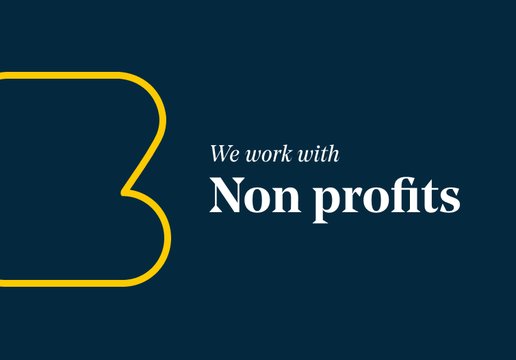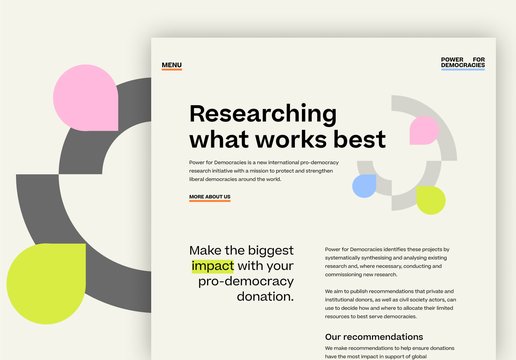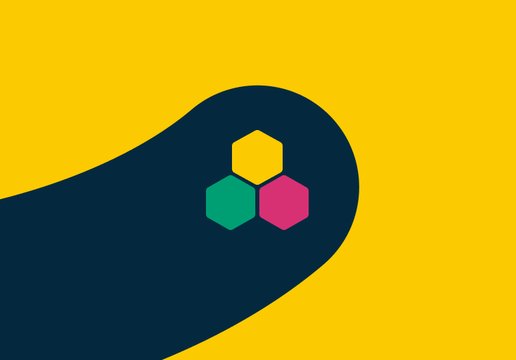Managing a platform for change can be stressful. But it doesn’t need to be.
We’re at a sweet spot in digital evolution for nonprofits: technology’s smarter, tools are friendlier, and you no longer need a computer science degree to hit publish. Still, we often hear from digital owners who feel like they’re one broken plugin away from a minor existential crisis. And we get it – some platforms are unnecessarily complex.
As specialist nonprofit software developers, we’ve spent almost 20 years cracking the code to sector-specific woes, turning digital headaches into practical, human solutions. Like the 16,000 buried pages we transformed into a smart filtering search system for a global think tank, or the values-driven platform we launched within six weeks – without relying on Big Tech for our nonprofit website hosting.
We’ve learned what makes a web platform truly work for organisations like yours. And we’re glad to share it with you.
What a ‘good’ nonprofit website really looks like
Your digital platform isn’t just there to describe your mission – it’s there to deliver, support, and scale it. Before we create a platform or website for nonprofit organisations, we dig deep to ensure we’re serving three core groups: the organisation, the users, and the team.
If your current setup feels more like a burden than an asset, something’s off. But the good news is, it’s fixable. When you find a platform that truly works how your team works, you’ll wonder how you ever managed the old way.
Platform choices that set you up for success
Your content management system (CMS) is far more than a technical decision – it shapes everything that follows. Your publishing workflow, your maintenance costs, your team’s sanity levels at 4pm on a Friday. All of it.
And yet, many nonprofits end up sticking with platforms that simply weren’t built to work how they work. We see it a lot: what begins as “we already know this system” can quickly become “we’re now managing 40+ plugins, getting weekly security alerts, and our publishing process takes six clicks per page because we've Frankensteined the thing to death."
Familiarity is lovely. But it’s not worth it if your platform fights you every step of the way.
Genuinely flexible, or flexible until it isn’t?
Every CMS claims to be flexible. But there’s a difference between “yes, we can technically do that (with an army of plugins)” and “yes, that’s just how this works”.
The problem with platforms that achieve flexibility through endless bolt-ons is that eventually, you end up with a Jenga tower of dependencies. One plugin updates, another breaks, and suddenly your donation form has disappeared.
We’ve tried pretty much every CMS to test what works best for our nonprofit clients. And what works best is Wagtail and Django – tools we’ve mastered because they’re genuinely built to match the pace, purpose, and pressure of our clients’ work.
What’s the deal with Wagtail?
We love Wagtail because it’s designed to shape around your workflows – not the other way round. Whether we’re simplifying complex content libraries, crafting nonprofit donation website flows, hosting global membership spaces, or keeping research repositories secure, it always delivers:
As Lincoln Loop’s Michael Trythall put it at Wagtail Space 2025: “Most organisations don’t abandon technology – they abandon poor experiences”. Wagtail makes non-techy teams feel confident and at ease, knowing exactly what their edits will do without breaking anything.
Wagtail’s grown 30% year-on-year and now powers up to 20,000 sites worldwide. But as Wagtail’s core team states: “We don’t have a responsibility to any shareholders to make Wagtail go up and to the right.“ You have peace of mind that it’s built for the long haul, not flashy trends.
Need a mammoth research platform to load tens of thousands of pages, eight times faster? We did it for ODI Global. Migrating 1,500 pages and 1,300 content modules from a rigid CMS while keeping a unique brand identity intact? We’re currently doing that for London-based nonprofit art organisation, Artangel – and can’t wait to show you the results. These aren’t one-off cases. They’re just Wagtail – and Wagtail specialists – doing our thing.
Nonprofits need to stand out in a crowded space. A consistent brand, mission, vision, and values aren’t just decorative – they’re crucial for turning visitors into supporters, and supporters into advocates. With Wagtail, there are no themes to squeeze into or constraints on look and feel. Everything is custom-designed and crafted to your brand guidelines, so your platform feels distinctly yours – not like every other nonprofit donation website out there.
Oh, and you’re in great company: Wagtail is the CMS of choice for the NHS, NASA, Oxfam, and Google.

The build matters – but so does what comes after
We often hear from clients who’ve been let down by digital agencies in the past. Agencies that treat launch day like it’s the finish line. Corks pop, invoices ping, and then… tumbleweed.
In our opinion, the best website builders for nonprofits don’t bail after the go-live. Instead, they stick around to support in the long run. Because your digital platform is a living thing: content evolves, user needs shift, security threats emerge, and that “quick fix” from six months ago starts causing problems elsewhere.
This is where most nonprofit digital teams get stuck. They’re firefighting instead of improving. Waiting weeks for tickets to get answered. Discovering simple content changes need developer time. Living in constant, low-level anxiety between high content turnarounds, bulky backlogs, and agency letdowns – all while waiting for something to break.
Partnering with a specialist agency that prioritises proactive digital care means you’ll catch issues before they become emergencies. Performance top-ups keep your platform fast. Security patches happen without drama. And when you need something, they’re already in your corner, ready to go.
Making it accessible and inclusive
The numbers don’t lie: 24% of people in the UK have a disability. As a mission-driven organisation, if your site isn’t inclusive, it’s fundamentally at odds with what you stand for. And from a stakeholder POV, you could be excluding one in five potential supporters, volunteers, donors, and beneficiaries before they’ve even had a chance to engage with your work. More than that, making sure no one is left behind is the right thing to do.
Accessibility isn’t just a nice-to-have in nonprofit website design – it’s a legal obligation. Most charities and nonprofit organisations are required by law to meet the WCAG 2.1 AA accessibility standard, and with the European Accessibility Act 2025 on the horizon, the stakes are only getting higher.
For your cause to move forward, you need people to act. But according to the 2025 WebAIM Million report, 94.8% of the top one million homepages have detectable WCAG failures – and nonprofits are no exception. Partnering with a team that truly understands accessible website design for nonprofit organisations means you won’t be locking anyone out of your platform, or your mission. In other words, you could be part of the rare 5.2% that actually gets it right – and that’s something to feel good about.
Bake your brand in creatively
Changemakers aren’t just competing with other causes – they’re also up against everything else vying for your audience’s attention. To stand out in a sea of cookie-cutter nonprofit websites, your brand needs to be baked into the very bones of your site. People should feel what you stand for before they’ve even read a word.
The colours, the copy, the considered details that delight without distracting – thoughtful touches in nonprofit website design can draw users deeper into your cause and keep them there. With Wagtail, every digital platform is custom-designed and crafted around your unique brand guidelines, so you don’t need to shoehorn your look and feel into off-the-shelf themes that flatten your identity.
Finding a digital partner to share the load
Whether you’re launching a fresh nonprofit donation website, improving what you’ve got, or rescuing a complex CMS that’s grown arms and legs – your agency choice shapes everything that follows.
So here’s what to look out for:
Red flags:
- Ghosts after launch. If they vanish once the site’s live, you’ve got a vendor, not a partner.
- Pushes rebuilds when improvements would work. Sometimes, a rebuild is needed. But if every conversation ends with “you need to start from scratch”, get a second opinion.
- Treats support as an afterthought. Fixing things when they break isn’t digital care, it’s firefighting with a price tag.
Green flags:
- Proactive, not reactive. They spot issues before you do and sort them without fuss.
- They speak your language. They already understand your world: mission-driven pressures, compliance needs, governance processes. You don’t need to explain what an impact report is for the third time.
- Long-term client relationships. If their clients stick around for years, that tells you something.
Ultimately, your agency should make it easy – putting thought into the best ways to make digital experiences work for you, your team, and the people you serve.
At Cursive, we’re web-building OGs. From specialist hosting requirements to mobile app development for nonprofits, we’ve been making and maintaining digital platforms built for people and purpose for almost 20 years. So, whatever problem you’re facing, it’s likely we’ve solved it before. And if we haven’t, we have a delightful open-source community behind us. It’s all figure-out-able – and we’re here to make it simple.


